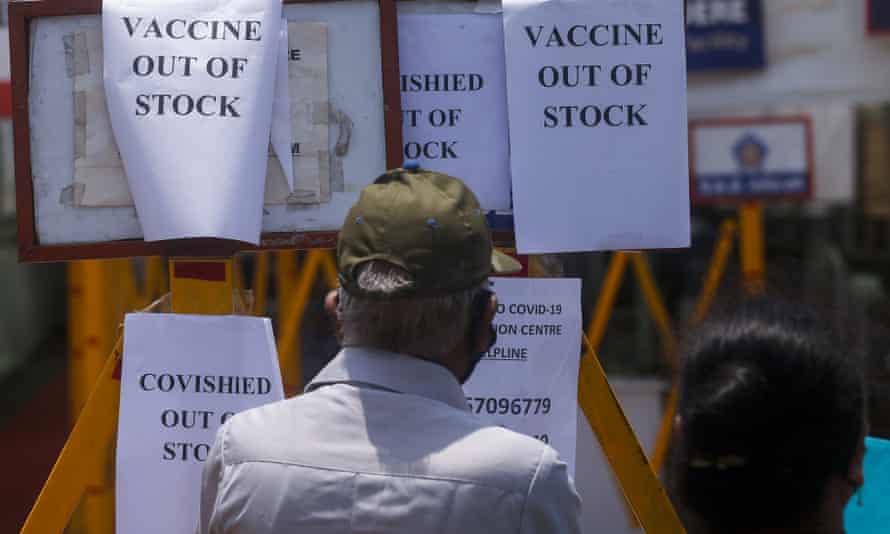India’s daily Covid deaths and infections hit new records on Saturday, but doctors and bereaved families have warned that even these bleak official statistics are seriously underestimating the scale of the country’s tragedy.
As a court in Delhi said India is facing not just a second wave but a “tsunami”, and hospitals had to turn patients away as they ran out of both beds and oxygen, people in many parts of India are still avoiding testing or struggling to access it.
“The figures on Covid infections that the government is releasing are actually an underestimate,” Dr Manas Gumta, general secretary of the Association of Health Service Doctors in West Bengal, told the Observer.
“A huge suspected Covid-positive population is certainly staying away from the tests. I believe the actual number of people dying of Covid is two to three times higher than what the government is reporting. And the number of infections could be up to five times than what is being reported by the Indian authorities.”
Saturday’s official toll recorded another 2,600 deaths and 340,000 new infections, bringing the total number of cases to 16.5 million, second only to the US. There have been 190,000 deaths attributed to Covid in India since the start of the pandemic.
But those figures don’t capture casualties like Nurul Amin, who ran a pharmacy in his village of Rajgram. He knew the warning signs for Covid, but when he developed fever and a cough as a second wave of the pandemic was crashing across India earlier this month, he refused to get tested.
“He insisted it was just an ordinary fever and he would get better with some medication,” his sister-in-law Zainab Begum said. “He told me the hospital was full of Covid patients and he would catch the disease if he went there.” Five days later, when the 58-year-old began struggling to breathe, his family raced him to a hospital but he died before he could be admitted, and was buried without ever being tested for the disease.
He is one of 10 people in the village suspected to have been killed by the disease, but never tested, while five people died after testing positive. Those figures suggest official data will be missing up to two thirds of Rajgram’s Covid losses.

“It appeared from their symptoms that those 10 were infected with Covid,” said Begum, a school teacher. “However in the official records, none of those deaths was identified as a Covid death.”
That rate of undetected Covid deaths is likely to be repeated across urban slums and poor rural areas, where the risks from Covid have not been well communicated, Gumta said.
Suspected cases could be counted in official statistics, under guidelines from the Indian Council of Medical Research, which allow diagnosis just by symptoms, Gumta said. But that discretion is rarely used to register cases, and there are also many who fall ill and don’t go to see a doctor.
“A small section of these people have access to proper health facilities or hospitals. But most patients with Covid-like symptoms here, and that is a huge number right now, just stay at home and try to treat themselves,” he said. “They are not reflected in any official figures.”
Rajgram is one of those places. The village was spared in the first wave of the pandemic, and did not lose any residents, which may also have contributed to complacency.
While Begum’s family have been scarred by their loss, and now wear masks and practise social distancing, that is unusual. “There is no awareness about Covid in our area. Villagers are not taking precautions, even in the crowded village market around 80% of people just roam around without masks,” she said.

Those behaviour patterns, and the scale of the current outbreak, mean both the official and hidden daily toll from Covid is likely to get worse before it gets better, experts say. The current wave is not expected to peak for two to three weeks.
There is increasing anger that government complacency may have allowed the virus to get out of control, after India appeared to have weathered the first year of the pandemic relatively well, and had a large-scale vaccination campaign under way.
Even as the second wave of the disease took hold, large scale election rallies were allowed to go ahead, as well as the Kumbh Mela religious festival, which brings together millions of pilgrims to bathe in the Ganges river.
“In the election rallies and the Kumbh Mela most people were not wearing face masks,” said Awesh Tiwari, a journalist-turned-social activist. “The government did not bother to halt those programmes and now we are paying the price.”
This content first appear on the guardian
